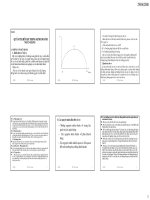slike bài giảng quản trị ngân hàng chương 9 liquidity & reserve management-strategies & policies
Bạn đang xem bản rút gọn của tài liệu. Xem và tải ngay bản đầy đủ của tài liệu tại đây (552.96 KB, 65 trang )
William Chittenden edited and updated the PowerPoint slides for this edition.
LIQUIDITY & RESERVE
MANAGEMENT:
STRATEGIES & POLICIES
Chapter 9
Key topics
1. Liquidity: Supply and Demand
2. Liquidity management strategies
3. Estimating liquidity needs
4. Legal reserves and money position management
5. Factor in choosing reserve sources
7-2
Liquidity
The availability of cash in the amount and at
the time needed at a reasonable cost
The size and volatility of cash requirements
affect the liquidity position of the bank
Examples:
Deposits and withdrawals;
Loan disbursements and loan payments
11-3
Supplies of liquid funds
Incoming customer deposits
Revenues from the sale of non-deposit services
Customer loan repayments
Sales of bank assets
Borrowings from the money market
11-4
Demands for liquidity
Customer deposit withdrawals
Credit requests from quality loan customers
Repayment of non-deposit borrowings
Operating expenses and taxes
Payment of stockholder dividends
11-5
11-6
A financial firm’s net liquidity position
L = Supplies of liquid funds
- Demands for liquidity
Liquidity deficit (L < 0)
Liquidity surplus (L > 0)
Time dimension of liquidity
immediate liquidity (CD due to mature, deposit
withdrawn tomorrow)
longer-term liquidity (arising from seasonal,
cyclical & trend factor)
→ manager must plan how, when & where liquid
fund can be raised
11-7
Quick quiz: Comprehensive problem
Suppose that a bank faces the following cash inflows and outflows
during the coming week:
1.deposit withdrawals are expected to total $33 million;
2.customer loan repayments are expected to amount to $108 million;
3.Operating expenses demanding cash payment will probably approach
$51 million;
4.Acceptable new loan requests should reach $294 million;
5.Sales of bank assets are projected to be $18 million;
6.New deposits should total $670 million;
7.Borrowings from the money market are expected to be about $43mil;
8.Non-deposit service fees should amount to $27 million;
9.Previous bank borrowings totaling $23mil are scheduled to be repaid;
&
10.A dividend payment to bank stockholders of $140 million is
scheduled.
What is this bank’s projected net liquidity position for the coming week?
11-8
Quick quiz: Comprehensive problem
L = Supplies of liquid funds
- Demands for liquidity
= (108 + 18 + 670 + 43 + 27 + 23) –
(33 + 51 + 294 + 140)
= 889 – 518
= 371
→ L > 0
→ Liquidity surplus
Essence of liquidity management
Rarely are the demands for liquidity equal to the
supply of liquidity at any particular moment. The
financial firm must continually deal with either a
liquidity deficit or surplus
There is a trade-off between liquidity and
profitability. The more resources tied up in
readiness to meet demands for liquidity, the
lower is the financial firm’s expected profitability.
High liquidity → high opportunity cost
Low liquidity → high interest cost & transaction cost
11-10
Why banks and their competitors face
significant liquidity problems?
Imbalances between maturity dates of their assets
and liabilities
High proportion of liabilities (especially demand
deposits and money market borrowings) subject to
immediate repayment
Sensitivity to changes in interest rates may affect
customer demand for deposits
customer demand for loans
cost to raise additional fund
High reliance on public confidence for reputation
11-11
Strategies for liquidity managers
1. Think about what is a liquid asset?
2. Identify strategies for liquidity management.
•
Strategies include:
1. Asset liquidity management (Asset conversion)
2. Borrowed liquidity or liability management
3. Balanced liquidity management
11-12
Asset liquidity management
This strategy calls for storing liquidity in the form
of liquid assets (T-bills, Fed funds loans, CDs,
etc.) and selling them when liquidity is needed.
Mainly used by small financial institutions, finding
that reliance on borrowing is a risky approach.
11-13
Liquid asset characteristics
Must have a ready market so it can be
converted to cash quickly
Must have a reasonably stable price
Must be reversible so an investor can recover
original investment with little risk of loss
11-14
Options for storing liquidity
1. Treasury bills
2. Fed funds sold to
other banks
3. Purchasing securities
for resale (Repos)
4. Deposits with
correspondent banks
5. Municipal bonds and
notes
6. Federal agency
securities
7. Negotiable certificates
of deposits
8. Eurocurrency loans
11-15
Asset liquidity management is not costless and
include opportunity cost:
Loss of future earnings on assets that must be sold
Transaction costs (commissions) on assets that
must be sold
Potential capital losses if interest rates are rising
May weaken appearance of balance sheet
Liquid assets generally have low returns
11-16
Borrowed liquidity (liability) management
This strategy calls for the bank to purchase or
borrow from the money market to cover all of its
liquidity needs.
Applied by large financial institutions
11-17
Sources of borrowed funds
1. Federal funds purchased
2. Selling securities for repurchase (Repos)
3. Issuing large CDs (> $100,000)
4. Issuing Euro-currency deposits
5. Securing advance from the Federal Home Loan
Bank (FHLB)
6. Borrowing reserves from the discount window
of the Federal Reserve
11-18
Borrowed liquidity (liability) management strategy
Advantages Disadvantages
Borrow only when there
is a need for funds
Volume and composition
of the investment
portfolio can remain
unchanged
The institution can control
interest rates in order to
borrow funds (raise offer
rates when needs
requisite amounts of
funds)
Highest expected return but
carries the highest risk due
to volatility of interest rates
and possible rapid changes
in credit availability
Borrowing cost is always
uncertain → uncertain
earnings
Borrowing needs can be
interpreted as a signal of
financial difficulties
11-19
Balanced liquidity management strategy
The combined use of liquid asset holdings (Asset
management) and borrowed liquidity (Liability
management) to meet liquidity needs.
Some expected demand for liquidity is stored in assets
Some liquidity needs are backed by arranged credit line
from potential fund suppliers
Unexpected cash needs are met by near-term borrowings
Longer-term liquidity needs are planned and parked in
short-& medium-term assets
11-20
Guidelines for liquidity managers
They should keep track of all fund-using and fund-
raising departments
They should know in advance withdrawals by the
biggest credit or deposit customers
Their priorities and objectives for liquidity
management should be clear
Liquidity needs must be evaluated on a continuing
basis
11-21
Methods for estimating liquidity needs
Sources and uses of funds approach
Structure of funds approach
Liquidity indicator approach
Signals from the marketplace
11-22
Sources and uses of funds
Key steps….
1. Loans and deposits must be forecast for a given
liquidity planning period
2. The estimated change in loans and deposits must
be calculated for the same planning period
3. The liquidity manager must estimate the bank’s net
liquid funds by comparing the estimated change in
loans to the estimated change in deposits.
11-23
11-24
Sources and uses of funds
Simpler approach….
Forecast of future deposit and loan growth is divided
into 3 components:
1. Trend component: a trend with constant growth is
estimated based on data in a long period
2. Seasonal component: changes in deposit or loan
due to seasonal factors
3. Cyclical component: deviation from the bank’s
expected deposits & loans depending on strength
or weakness of the economy in the current year.
11-25









